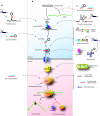Novel RNA-based strategies for therapeutic gene silencing
- PMID: 20087319
- PMCID: PMC2839433
- DOI: 10.1038/mt.2009.306
Novel RNA-based strategies for therapeutic gene silencing
Abstract
The past decade has seen intense scientific interest in non-coding RNAs. In particular, the discovery and subsequent exploitation of gene silencing via RNA interference (RNAi) has revolutionized the way in which gene expression is now studied and understood. It is now well established that post-transcriptional gene silencing (PTGS) by the microRNA (miRNA) and other RNAi-associated pathways represents an essential layer of complexity to gene regulation. Gene silencing using RNAi additionally demonstrates huge potential as a therapeutic strategy for eliminating pathogenic gene expression. Yet despite the early promise and excitement of gene-specific silencing, several critical hurdles remain to be overcome before widespread clinical adoption. These include off-target effects, toxicity due to saturation of the endogenous RNAi functions, limited duration of silencing, and effective targeted delivery. In recent years, a range of novel strategies for producing RNA-mediated silencing have been developed that can circumvent many of these hurdles, including small internally segmented interfering RNAs, tandem hairpin RNAs, and pri-miRNA cluster mimics. This review discusses RNA-mediated silencing in light of this recent research, and highlights the benefits and limitations conferred by these novel gene-silencing strategies.
Figures


Similar articles
-
An update on RNA interference-mediated gene silencing in cancer therapy.Expert Opin Biol Ther. 2014 Nov;14(11):1581-92. doi: 10.1517/14712598.2014.935334. Epub 2014 Jul 10. Expert Opin Biol Ther. 2014. PMID: 25010067 Review.
-
Therapeutic potentials of gene silencing by RNA interference: principles, challenges, and new strategies.Gene. 2014 Apr 1;538(2):217-27. doi: 10.1016/j.gene.2013.12.019. Epub 2014 Jan 7. Gene. 2014. PMID: 24406620 Review.
-
Potentiality of small interfering RNAs (siRNA) as recent therapeutic targets for gene-silencing.Curr Drug Targets. 2007 Mar;8(3):469-82. doi: 10.2174/138945007780058988. Curr Drug Targets. 2007. PMID: 17348839 Review.
-
Construction of simple and efficient DNA vector-based short hairpin RNA expression systems for specific gene silencing in mammalian cells.Methods Mol Biol. 2007;408:223-41. doi: 10.1007/978-1-59745-547-3_13. Methods Mol Biol. 2007. PMID: 18314586
-
RNA interference-based gene therapy for successful treatment of rheumatoid arthritis.Expert Opin Biol Ther. 2009 May;9(5):535-8. doi: 10.1517/14712590902926089. Expert Opin Biol Ther. 2009. PMID: 19392574 Review.
Cited by
-
Promoter Targeting shRNA Suppresses HIV-1 Infection In vivo Through Transcriptional Gene Silencing.Mol Ther Nucleic Acids. 2013 Dec 3;2(12):e137. doi: 10.1038/mtna.2013.64. Mol Ther Nucleic Acids. 2013. PMID: 24301868 Free PMC article.
-
Gadolinium embedded iron oxide nanoclusters as T1-T2 dual-modal MRI-visible vectors for safe and efficient siRNA delivery.Nanoscale. 2013 Sep 7;5(17):8098-104. doi: 10.1039/c3nr02797j. Nanoscale. 2013. PMID: 23884164 Free PMC article.
-
Nanoparticle-antagomiR based targeting of miR-31 to induce osterix and osteocalcin expression in mesenchymal stem cells.PLoS One. 2018 Feb 14;13(2):e0192562. doi: 10.1371/journal.pone.0192562. eCollection 2018. PLoS One. 2018. PMID: 29444183 Free PMC article.
-
Position-dependent effects on stability in tricyclo-DNA modified oligonucleotide duplexes.Nucleic Acids Res. 2011 Jan;39(1):373-80. doi: 10.1093/nar/gkq733. Epub 2010 Aug 17. Nucleic Acids Res. 2011. PMID: 20719742 Free PMC article.
-
A simple and robust vector-based shRNA expression system used for RNA interference.PLoS One. 2013;8(2):e56110. doi: 10.1371/journal.pone.0056110. Epub 2013 Feb 6. PLoS One. 2013. PMID: 23405258 Free PMC article.
References
-
- Mercer TR, Dinger ME., and , Mattick JS. Long non-coding RNAs: insights into functions. Nat Rev Genet. 2009;10:155–159. - PubMed
-
- Birney E, Stamatoyannopoulos JA, Dutta A, Guigó R, Gingeras TR, Margulies EH, ENCODE Project Consortium; NISC Comparative Sequencing Program; Baylor College of Medicine Human Genome Sequencing Center; Washington University Genome Sequencing Center; Broad Institute; Children's Hospital Oakland Research Institute et al. Identification and analysis of functional elements in 1% of the human genome by the ENCODE pilot project. Nature. 2007;447:799–816. - PMC - PubMed
Publication types
MeSH terms
Substances
Grants and funding
LinkOut - more resources
Full Text Sources
Other Literature Sources
Medical
Miscellaneous

